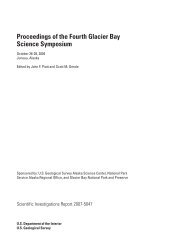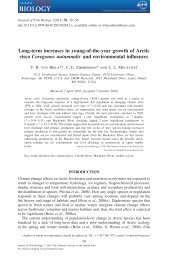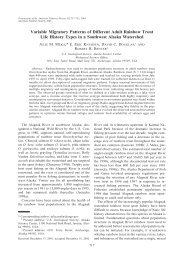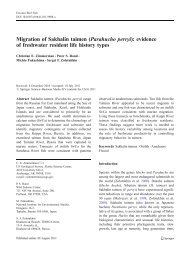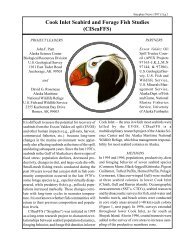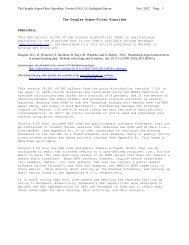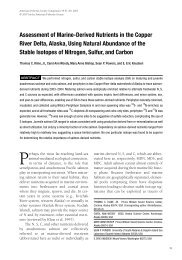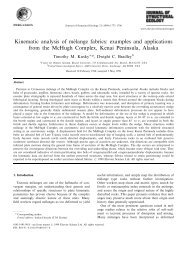Mexican native trouts: a review of their history and ... - Webspace
Mexican native trouts: a review of their history and ... - Webspace
Mexican native trouts: a review of their history and ... - Webspace
Create successful ePaper yourself
Turn your PDF publications into a flip-book with our unique Google optimized e-Paper software.
278<br />
Findings<br />
<strong>Mexican</strong> <strong>trouts</strong> past <strong>and</strong> present<br />
The <strong>Mexican</strong> fossil record<br />
The marine anadromous fauna, including salmonids,<br />
that now characterizes North American Pacific drainages<br />
<strong>of</strong> the United States, extended during Pleistocene<br />
at least as far south as the <strong>Mexican</strong> Mesa (Plateau)<br />
Central to about 21 ◦ N latitude (Miller <strong>and</strong> Smith,<br />
1986). Though <strong>Mexican</strong> salmonid fossils are fragmentary,<br />
<strong>and</strong> thus difficult to relate to modern forms, they<br />
have been referred to two species in the modern genus<br />
Oncorhynchus (Cavender, 1986; Cavender <strong>and</strong> Miller,<br />
1982) (or the extinct Rhabd<strong>of</strong>arío (Smith, 1980;<br />
Smith, 1981). Though salmonids did not persist on the<br />
Mesa Central to modern times, other components <strong>of</strong><br />
this same ancestral fauna apparently did; two lampreys<br />
<strong>of</strong> the genus Lampetra (subgenus Tetrapleurodon)are<br />
l<strong>and</strong>locked on the Mesa Central (Cochran et al., 1996;<br />
Lyons et al., 1994; Lyons et al., 1996), far south<br />
<strong>of</strong> <strong>their</strong> nearest relatives in Baja California (Ruiz-<br />
Campos <strong>and</strong> Gonzalez-Guzman, 1996).<br />
To our knowledge, the only fossil fishes known<br />
from within or near the present range <strong>of</strong> <strong>Mexican</strong><br />
<strong>native</strong> <strong>trouts</strong> include those from the Pliocene fauna<br />
<strong>of</strong> Yepómera, Chihuahua (southern Río Yaqui –<br />
Papigochi sub-basin). Though mammals, birds <strong>and</strong><br />
other components <strong>of</strong> that fauna have been well studied<br />
(Lindsay <strong>and</strong> Jacobs, 1985, Smith, 1981), to our<br />
knowledge the fossil fishes have yet to be described<br />
beyond M.L. Smith’s (1981) very brief mention<br />
only <strong>of</strong> a cyprinid <strong>and</strong> an unidentified, possible<br />
cyprinodontoid. The site appears, however, to be<br />
the only fossil fish locality within the present range<br />
<strong>of</strong> <strong>native</strong> <strong>trouts</strong>, being in the southern Río Yaqui<br />
(Papigochi) basin. Slightly outside <strong>of</strong> the currently<br />
known range <strong>of</strong> <strong>native</strong> <strong>trouts</strong>, but perhaps within<br />
prehistoric range, are two fossil fish localities. A Holocene<br />
cave deposit in Durango (Brooks et al., 1962) in<br />
the Río Nazas basin contains three families <strong>of</strong> fishes<br />
still found in the area, but typical <strong>of</strong> lower elevations<br />
than trout. The La Brean fauna from Rancho La Brisca<br />
(Van Devender et al., 1985) in the Río Sonora basin<br />
(the next major basin west <strong>of</strong> the Río Yaqui), had<br />
few fish remains typical <strong>of</strong> species found today very<br />
near the fossil locality at elevations well below those<br />
typical for trout.<br />
Recent <strong>native</strong> <strong>trouts</strong><br />
Living <strong>Mexican</strong> <strong>native</strong> <strong>trouts</strong> currently consist <strong>of</strong><br />
two described forms, the <strong>Mexican</strong> golden trout, O.<br />
chrysogaster (Needham <strong>and</strong> Gard, 1964) <strong>of</strong> the ríos<br />
Fuerte, Sinaloa <strong>and</strong> Culiacán, <strong>and</strong> the Baja California<br />
rainbow trout, O. mykiss nelsoni (Evermann, 1908)<br />
<strong>of</strong> the Sierra San Pedro Mártir in northern Baja<br />
California. Native <strong>trouts</strong> known from the mainl<strong>and</strong><br />
north <strong>of</strong> the <strong>Mexican</strong> golden trout in the ríos Yaqui,<br />
Mayo <strong>and</strong> Guzmán systems remain undescribed, but<br />
specimens <strong>of</strong> these forms are relatively abundant in<br />
museum collections compared to those from further<br />
south from the ríos San Lorenzo, Piaxtla, Presidio,<br />
Baluarte <strong>and</strong> Acaponeta. Whether these forms from<br />
south <strong>of</strong> <strong>Mexican</strong> golden trout are <strong>native</strong> or introduced<br />
or hybrids <strong>of</strong> <strong>native</strong> <strong>and</strong> introduced forms remains<br />
contested as mentioned above. We recently collected<br />
additional specimens from most <strong>of</strong> these basins <strong>and</strong><br />
discuss them below.<br />
Early explorations, observations <strong>and</strong> collections<br />
The <strong>history</strong> <strong>of</strong> observations <strong>of</strong> trout in Mexico<br />
goes back further than previously reported. We<br />
report below a number <strong>of</strong> formerly overlooked early<br />
observations in a chronological <strong>review</strong> <strong>of</strong> collections<br />
<strong>and</strong> observations <strong>of</strong> specimens from the study area.<br />
Other similar, but site-specific <strong>and</strong> more habitatoriented<br />
observations <strong>and</strong> selected extracts from<br />
interviews, archives <strong>and</strong> personal communications are<br />
reported later in our <strong>review</strong>s <strong>of</strong> habitat <strong>and</strong> fish faunal<br />
histories.<br />
James Woodhouse Audubon. More than 150 years<br />
ago, James Woodhouse Audubon (son <strong>of</strong> John James<br />
Audubon) traveled across Chihuahua enroute to northwestern<br />
Sonora as second in comm<strong>and</strong> <strong>of</strong> a group <strong>of</strong><br />
about 100 men. Crossing the ríos Florido, Conchos,<br />
<strong>and</strong> Yaqui, he mentioned in his journal (Audubon,<br />
1906) that on July 3rd, 1849, near the town <strong>of</strong><br />
“Tomochi,” he <strong>and</strong> his crew<br />
... looked in vain for fish in the most tempting<br />
<strong>of</strong> eddies <strong>and</strong> holes, but saw very few; little<br />
trout about five inches long were all that rewarded<br />
our search. We crossed <strong>and</strong> recrossed this stream<br />
twenty-two times in about seven miles, <strong>and</strong><br />
encamped on a s<strong>and</strong>y bottom covered with fine<br />
pines.<br />
Though overlooked by earlier researchers, this<br />
appears to be the first written report <strong>of</strong> trout in<br />
Mexico <strong>and</strong> it is not difficult to place the locality




